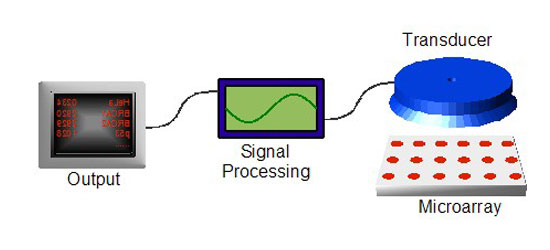Sections
Biochip is specially designed microchips which are constructed to perform biological researches. This new technology has initiated the scientists to untangle the science behind the various biochemical reactions occurring inside the cells. By far this new technology has helped in the advancement of medical science and educated the scientists to treat several diseases. The technological developers play a vital role along with the bio-scientists to invent such hi-tech components. The developers are into the unending research of creating innovation and development in the field of these microelectromechanical systems. Nowadays the huge primitive machineries that were used in the laboratories of bio-scientists have been abandoned and are replaced with this small biochip new technology which performs more efficiently. These new technology biochip are themselves miniaturized laboratories.

Kary Mullis in the year 1983 invented the component in living organisms which are considered as their official carrier of genetic informations. This component was termed as DNA i.e. deoxyribonucleic acid which was visible in the polymerase chain reaction technique first conducted by him. Then later in 1986, Hood and his co-scientists, in order to detect hybridization of DNA molecules optically, invented a process to label DNA molecules with fluorescent marking instead of radio-marking.
After the discovery of Sensor Technology, Hughes in the year 1922, created an impact by inventing the chemistry-based sensor with the help of glass pH electrode. Now this sensor technology was incorporated in the DNA based genetic researches to attain a complete analytical study of the DNA component. This was when biochip came to existence as a new technology.
As the name suggests, biological analysis is performed with the help of a chip which is practically a sensing component.
This procedure is made to perform with the help of various new technology devices at a proper multi-disciplinary order. The new technology components required to create the biochip platform starts from microarrays to transducer to signal processor which finally conveys the data to the designated output.

Microarrays are typically a flat substrate on which the sensor components are placed and then with the help of surface chemistry, the sensor components are covalently bonded to the surface of the substrate. The microarrays consist of two-dimensional Cartesian grid of sensor which help in mapping each sensor to its respective functions. Its substrate is either made of silicon or glass device or may be some integrated electronic device which helps in signal transmission. The Cartesian grids are the arrays on which the sensor is placed for sending signals. Each array of the microarrays is connected to a particular function which serves the purpose of transmitting the data of the right sensor in the right direction. For this reason, the sensor has to be placed on the right array. This was a very tedious task. To improvise the entire technique, microarrays were randomly fabricated. In this case, the sensor could be placed randomly on the substrate for them to map to their respective functions.
Microarrays are used in DNA analysis, protein microarrays, antibody microarrays and chemical microarrays as a new technology. But the best part is that microarrays can also be formulated using biochip. This is called Biochip Array technology in which the substrate is replaced with a biochip. This biochip then analyzes any number of related tests from a single sample of the patient and finally produces his complete medical profile. This entire profile of the patient helps the bio-technician to detect any kind of disease originating in the patient which helps in further treatment procedure conducted by the doctor.
Transponder implanted in a biochip can be passive as well as active. Transponder does all the function of a biochip and hence is addressed as an implanted biochip. A passive transponder does not have any battery or energy and so it does not work until it is activated by the reader via low-power charging. Being a no-battery device, it does not wear out resulting in a long life span. Communication between the reader and biochip is through low frequency radio-waves. Let us demonstrate the components that make up a biochip-transponder as a new technology.

The biochip is inserted in the patient body with the help of a hypodermic syringe. This procedure is very simple, painless and is carried without anesthesia. This biochip then sends data to reader with the help of radio-transmission. The reader then encodes the data to display the output on the screen.
The most important fact about biochip as a new technology is that doctors can easily detect multiple numbers of diseases with a single insertion.
Sections